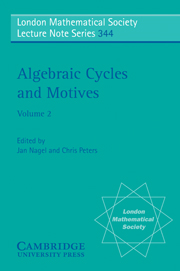Book contents
- Frontmatter
- Contents
- Contents of Volume 1
- Preface
- Volume 2 Research Articles
- 1 Beilinson's Hodge Conjecture with Coefficients
- 2 On the Splitting of the Bloch–Beilinson Filtration
- 3 Künneth Projectors
- 4 The Brill–Noether Curve of a Stable Bundle on a Genus Two Curve
- 5 On Tannaka Duality for Vector Bundles on p-adic Curves
- 6 On Finite-dimensional Motives and Murre's Conjecture
- 7 On the Transcendental Part of the Motive of a Surface
- 8 A Note on Finite Dimensional Motives
- 9 Real Regulators on Milnor Complexes, II
- 10 Motives for Picard Modular Surfaces
- 11 The Regulator Map for Complete Intersections
- 12 Hodge Number Polynomials for Nearby and Vanishing Cohomology
- 13 Direct Image of Logarithmic Complexes
- 14 Mordell–Weil Lattices of Certain Elliptic K3's
15 - Motives from Diffraction
Published online by Cambridge University Press: 05 April 2013
- Frontmatter
- Contents
- Contents of Volume 1
- Preface
- Volume 2 Research Articles
- 1 Beilinson's Hodge Conjecture with Coefficients
- 2 On the Splitting of the Bloch–Beilinson Filtration
- 3 Künneth Projectors
- 4 The Brill–Noether Curve of a Stable Bundle on a Genus Two Curve
- 5 On Tannaka Duality for Vector Bundles on p-adic Curves
- 6 On Finite-dimensional Motives and Murre's Conjecture
- 7 On the Transcendental Part of the Motive of a Surface
- 8 A Note on Finite Dimensional Motives
- 9 Real Regulators on Milnor Complexes, II
- 10 Motives for Picard Modular Surfaces
- 11 The Regulator Map for Complete Intersections
- 12 Hodge Number Polynomials for Nearby and Vanishing Cohomology
- 13 Direct Image of Logarithmic Complexes
- 14 Mordell–Weil Lattices of Certain Elliptic K3's
Summary
Abstract
We look at geometrical and arithmetical patterns created from a finite subset of ℤn by diffracting waves and bipartite graphs. We hope that this can make a link between Motives and the Melting Crystals/Dimer models in String Theory.
Introduction
Why is it that, occasionally, mathematicians studying Motives and physicists searching for a Theory of Everything seem to be looking at the same examples, just from different angles? Should the Theory of Everything include properties of Numbers? Does Physics yield realizations of Motives which have not been considered before in the cohomological set-up of motivic theory? Calabi-Yau varieties of dimensions 1 and 2, being elliptic curves and K3-surfaces, have a long and rich history in number theory and geometry. Calabi-Yau varieties of dimension 3 have played an important role in many developments in String Theory. The discovery of Mirror Symmetry attracted the attention of physicists and mathematicians to Calabi-Yau's near the large complex structure limit [13, 20]. Some analogies between String Theory and Arithmetic Algebraic Geometry near this limit were discussed in [16, 17, 18]. Recently new models appeared, called Melting Crystals and Dimers [14, 11], which led to interesting new insights in String Theory, without going near the large complex structure limit. The present paper is an attempt to find motivic aspects of these new models.
- Type
- Chapter
- Information
- Algebraic Cycles and Motives , pp. 340 - 360Publisher: Cambridge University PressPrint publication year: 2007
- 1
- Cited by

